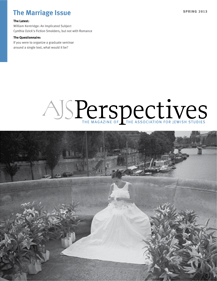There is a Jewish expression, “When you have one Jew, you’ll have two synagogues; two Jews, you will have three opinions, but when it comes to marriage, the rabbis say that two Jews can have five different models of matrimony . . . and some say six.”
In Jewish law there are five different models for what constitutes a Jewish marriage, and each model is based on a contractual view. This differs from Christian views, which consider marriage as either sacramental, as in Catholicism, or covenantal, as among many Protestant denominations. It also differs from the view of marriage in European civil law, as well as the Anglo-American conception of common law marriage, as being a matter of public law, where the state defines the nature of what constitutes marriage. (This is not to be confused with common law marriages, which are, in fact, also a matter of public law.) Marriage in Jewish law, on the other hand, is solely a contract between private parties, who agree to wed based on personal preferences and agreed-upon terms.
Determining the nature of Jewish marriage is as much a matter of understanding how it commences as it is of knowing how it can end, as the Yiddish expression goes, “Before you marry, make sure you know whom you are going to divorce.” When we delineate the different models of Jewish marriage, we must also delineate the role that divorce plays in ending them.
The first model of Jewish marriage is the one provided in the Torah. Marriage is typically monogamous, could be polygamous, but is never polyandrous. Divorce can be unilaterally initiated by the husband, and, according to the majority opinion, there is no obligation to provide a dowry (ketubah) according to Biblical law, although to do so was a firm and ancient custom.
The second model, which emerges in the rabbinic period, differs in that it provides for greater security for the man’s wife or wives. Dowries are obligatory and are a precondition of marriage. Even though divorce remains the unilateral prerogative of the husband, it is limited by the financial obligation to pay the ketubah. Some Talmudic opinions even posit that a husband cannot divorce his wife if he cannot pay her the agreed upon sum established in the ketubah. Moreover, in the case of fault, if either party breaks the original terms or assumptions of the marriage, the rabbinical court can impose an obligation to divorce, either without financial obligation for the husband if the wife is at fault or with financial obligation if fault is the husband’s.
The third model for Jewish marriage arises in the Geonic period (589–1038). Although marriages could still be polygamous, if a woman wanted to leave her marriage she had the right to sue for divorce and still retain her ketubah. Some rabbinic courts went even farther and annulled marriages when the woman requested it through a special decree called “the decree of the academy.” This meant that both the start and the continuation of marriage had to be voluntary by both parties. A similar model was advocated by Maimonides (without the decree of the academy and with a court-ordered divorce), and was normative among the Yemenite communities. This view of marriage is most similar to a pure contractual partnership.
The fourth model was established by the decree of Rabbenu Gershom, leader of European Jewry at the end of the tenth and beginning of the eleventh century. Both husband and wife have the equal right to divorce, but the pure contract model restricts the rights of the husband. Whereas the Geonic model allows either partner to initiate divorce, Rabbenu Gershom established that both parties voluntarily agree to end the marriage as well. Moreover, Rabbenu Gershom greatly limited the types of divorce considered to arise from fault and also abolished polygamy. This created a model in which marriage was seen more significantly as a bonding of two people into a union rather than a contractual agreement between partners. There was no divorce absent mutual consent or hard fault.
The fifth model for Jewish marriage is a modified version of the fourth model, for it accepts the equalization of partners established by Rabbenu Gershom. The difference is that the fifth model provides an exit when the marriage has in fact deteriorated past the point of recovery, whereas Rabbenu Gershom’s model does not. When the marriage is working, neither party can end it unilaterally. When the marriage is over in all but name, however, either party could initiate divorce, and neither party may refuse. First advocated by German Jewish law authorities in the thirteenth century (and found in the Or Zaruah), many others have adopted it since.
Jewish marriage in America is further complicated by its relationship with secular marriage (and divorce) law. This is a uniquely modern issue. At no other time in history did the state impose its marriage laws on the Jewish community. The influence of secular law on Jewish marriage creates a possible sixth model in which Jewish couples marry according to secular laws and customs, and Jewish law accommodates secular law, while imposing Jewish ritual on it. The difficulty with this model is that while the other five models, regardless of their differences, maintain that marriage is a private affair, this model of Jewish marriage imposes public law, and therefore secular social mores, onto a conception of Jewish marriage. Public law conceives of marriage as a creation of the state; therefore, agents of the state define its terms rather than solely adjudicate potential disputes, as they would in any other private dispute. In practice, many perceive this hybrid simply as an isomorphic arrangement, where husband and wife are actually married twice, and potentially divorced twice. The fact that marriage is seen through the lens of two different conceptual systems, however, can cause difficulties when the underlying principles of the different conceptions diverge. When this occurs, the dominant legal system will cause the weaker legal system to adapt. When it is impossible for the weaker legal system to do so, it creates a dilemma for the weaker system that causes more harm to its adherents than concomitantly being under the dominant system is meant to help them. A dilemma occurs when adaption to a situation is impossible: Does the weaker system rebel and take a position that conflicts with the superior legal system? Or does it acquiesce to the superior system and accept a legal situation which contradicts its own ideals to its detriment and possible legitimacy?
An example of this dilemma can be seen by the controversy initiated by two get laws in the state of New York. The 1984 Get Law prevented a person from initiating a civil divorce before completing a religious divorce, avoiding a divergence between secular and Jewish law since the state cannot impose itself on its religious counterpart. It harmonized New York law with Jewish law. Yet the secular law does not address the problem of a recalcitrant husband not issuing a religious divorce or granting a secular divorce. The 1992 Get Law, on the other hand, allows secular law to impose itself on Jewish law by financially penalizing a husband who refuses to give his wife a religious divorce. Though the intent of the law is to maintain harmony between secular and Jewish law by forcing the two divorces to occur at the same time, it imposes a secular marriage principle—namely that of the right for a unilateral no-fault divorce—on current conceptions of Jewish marriage. This right is absent in all but the Geonic model and in the rulings of Maimonides, and is nowhere normative in contemporary Jewish law.
When confronted with irreconcilable contradictions, such as this one, there are three different ways to respond. Jewish law can defer to secular law, it can ignore secular law, and it can avoid the conflict by circumventing it. The first two options are generally impractical, since most American Jewish communities wish to live according to both Jewish and secular law (for example, the community does not want its Jewish marriages to be invisible to secular law). To defer or to ignore either system is simply not a feasible choice. Circumventing the issue, on the other hand, calls for juridical creativity but it also increases the role of Jewish courts in adjudicating matters of marriage.
Jewish law can maintain its own conception of marriage and prevent coercion by secular law if potential husbands and wives sign a prenuptial agreement. Each party would be bound to meet certain obligations if either party later disregards the agreement. Jewish courts would then arbitrate end-of-marriage disputes so that the result is in accordance with the prenuptial agreement, as well as the halakic norms and values of the Jewish community to which the couple belongs (for an example by the leading Orthodox Jewish law court in America, the Beth Din of America, see www.theprenup.org).
Though Biblical and philosophic texts often portray Jewish marriage as a bond by which man and woman become one flesh, or a single soul, the historical conception of Jewish marriage as conveyed by Jewish law tells a different story. Jewish marriage is sometimes considered as a metaphysical union, yet it is also a private contractual arrangement. In the past it has been polygamous, though today it is monogamous. Like many other areas in Jewish law, what is considered permissible falls within a given range, and what is considered normative is historically and socially influenced by the ebb and flow of rabbinic history.


 Ira Bedzow is the Director of the Biomedical Ethics and Humanities Program and Assistant Professor of Medicine in the Department of Medicine at New York Medical College. He is also Senior Scholar of the Aspen Center for Social Values. He is the author of Halakhic Man, Authentic Jew: Modern Expressions of Orthodox Thought (Lambda Publishers, 2009), and a book of poetry, Things Overheard in the Synagogue (Urim Publications, 2012).
Ira Bedzow is the Director of the Biomedical Ethics and Humanities Program and Assistant Professor of Medicine in the Department of Medicine at New York Medical College. He is also Senior Scholar of the Aspen Center for Social Values. He is the author of Halakhic Man, Authentic Jew: Modern Expressions of Orthodox Thought (Lambda Publishers, 2009), and a book of poetry, Things Overheard in the Synagogue (Urim Publications, 2012).